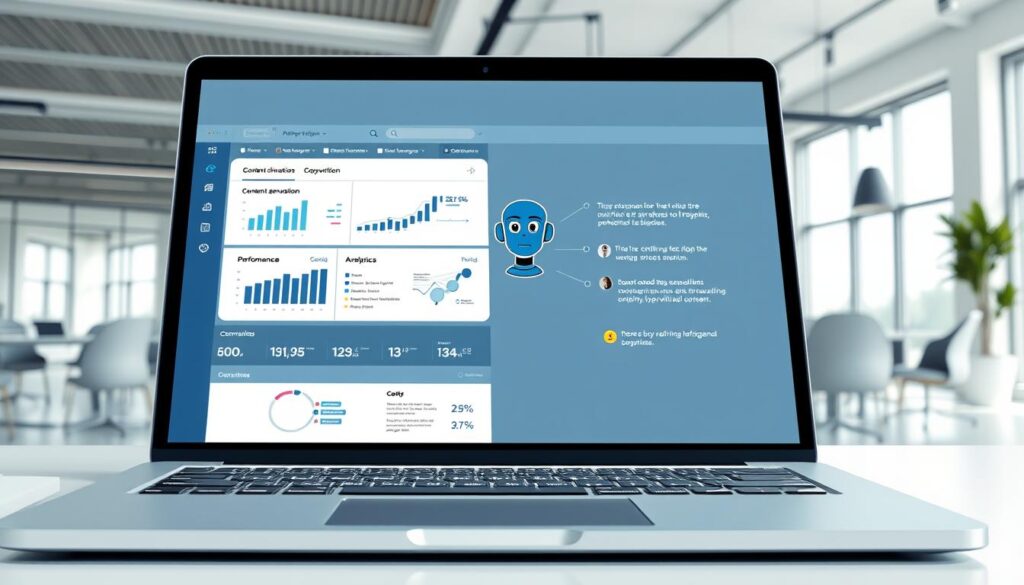I remember when my idea for a digital product hit me. It was while I was scrolling through Reddit. Someone in my niche had an idea I could make better significantly.
Thanks to AI, I made that idea real in just 7 days. In this article, I’ll tell you how I used AI to make a digital product. I’ll also share what I learned.
My story shows that with the right tools and creativity, you can make your ideas real. And start making money.
Key Takeaways
- Discover how to turn your idea into a profitable digital product.
- Learn the role of AI in streamlining the product creation process.
- Understand the importance of leveraging the right tools for success.
- Find out how to bring your product to market quickly and efficiently.
- Explore the AI in business strategy.
My Digital Product Creation Journey
I decided to make a digital product with AI. Here’s how it went. I asked my audience, “What’s the biggest problem you’re having with your digital product creation?” This question helped me understand their needs. It led to my AI-powered eBook.
Why I Decided to Create an AI-Powered eBook
I wanted to make an AI-powered eBook because of the demand for digital products. AI can make creating products faster and better. This idea excited me to see what I could do.
The Power of the 7-Day Timeline
Setting a 7-day timeline was tough but motivating. It made me work fast and well. I had to pick what to do first, use the best tools, and work hard to make my idea real.
My Background and Starting Point
I had experience in making digital products. I knew about doing research, making good content, and marketing. This experience made me confident to start this project. I was ready to use my knowledge to make a great AI-powered eBook.
Finding a Profitable Digital Product Idea
Finding a profitable digital product idea takes a lot of work. First, you need to find a niche with lots of demand but not too much competition.
Market Research Techniques I Used
I used many ways to find the right niche. I looked at trending topics and what people are interested in online. This showed me where the demand is high.
Tools like Google Trends and keyword research software helped me see how popular topics are. They also showed me the right keywords to use.

Validating My Product Concept
After finding some ideas, I checked if they could make money. I looked for niches with lots of people but not too many products.
I analyzed what’s already out there, read reviews, and figured out what my audience wants.
Tools That Helped Me Identify Opportunities
Many tools helped me find good opportunities. I used market research reports, social media tools, and online forums.
- Market research reports gave me insights into what people want and like.
- Social media tools showed me what my audience is talking about.
- Online forums helped me see what my customers need and want.
By using these tools and methods, I found a digital product idea that my audience wants.
Planning My Digital Product Development
To make my idea real, I needed a good plan. I had only 7 days to do it. So, I broke down the work into smaller tasks.
Creating a 7-Day Action Plan
I first figured out what my digital product needed. This included content, design, setup, and marketing. I planned out each day’s work to keep things balanced.
Setting Realistic Milestones
It was key to set goals I could reach. I sorted tasks by how important and urgent they were. This way, I could adjust if needed.
Resources I Gathered Before Starting
Before starting, I got all the tools I needed. I used AI tools, design software, and marketing templates. Having these ready saved me a lot of time.
“I got insane results even in the first 30 days.” This quote shows how important planning and doing are for success.
Here’s a quick look at the tools I used and why:
| Resource | Purpose |
|---|---|
| ChatGPT | Content generation and editing |
| Midjourney | Design and visual content creation |
| Design software | Product design and branding |
How to Create a Digital Product Using AI Tools
In my journey to build a digital product in 7 days, AI tools were key. They made the development process smoother and improved the product’s quality.
ChatGPT, Midjourney, and Other AI Tools I Used
I used many AI tools to make my digital product. ChatGPT helped make great content. Midjourney made the graphics look good. I also used tools for language and content optimization.
These AI tools helped in several ways:
- Creating content
- Making designs
- Improving content
Comparing Different AI Solutions
Choosing AI tools means looking at their features, cost, and if they fit your needs. I compared ChatGPT with Jasper. ChatGPT was the best value for me.

Prompt Engineering Techniques That Worked
Learning to write good prompts for AI was a big part of my project. Making the right prompts for tools like ChatGPT made the results better. I found that specific, well-structured prompts worked best.
Some good ways to write prompts include:
- Being clear about what you want the AI to do
- Adding context and background info
- Improving prompts based on AI’s first try
Using these AI tools and techniques, I made a great digital product fast.
Day 1-2: Content Creation and Product Design
Starting my digital product journey was exciting. The first two days were all about making great content and designing something cool. I wanted to make something that my audience would love.
Leveraging AI for Content Generation
I used AI tools like ChatGPT to make content. These tools helped me create a lot of content fast. For example, I used ChatGPT to write a first draft of my eBook. Then, I made it better and edited it.
Studies show AI content can be as good as human-made content. It’s because AI looks at lots of data and finds patterns that people like.
“The best way to get good ideas is to get a lot of ideas.” This quote, often attributed to Linus Pauling, highlights the importance of content generation in the creative process.
Design Elements That Sell
Design is key to selling a product. People buy what looks good to them. So, I worked hard on making my product look nice. I used tools like Midjourney to make great images.
| Design Element | Importance | Tools Used |
|---|---|---|
| Visual Appeal | High | Midjourney |
| Color Scheme | Medium | Adobe Color |
| Typography | High | Google Fonts |
Quality Control and Human Touch
AI tools helped a lot with making content and design. But, I knew I had to check everything myself. I reviewed and edited AI content to make it feel more personal and real to my audience.
By using AI for speed and my own judgment for quality, I made a great digital product. It really connected with my target market.
Day 3-4: Building the Product Infrastructure
Days three and four were all about building the product infrastructure. This was key to making sure my digital product had a strong base. I worked hard to set up the right platforms and tools for a great user experience.
Platforms and Software I Used
I picked Shopify for my e-commerce needs because it’s easy to use and has great features. I also used Gumroad for delivering digital products smoothly. For email marketing, I went with Mailchimp for its easy setup and cool features.

Automation Techniques That Saved Time
I used Zapier to link apps and automate tasks. This cut down on time and mistakes. It made my work flow better.
Troubleshooting Common Issues
Setting up faced some bumps, like linking software and making sure payments were safe. I fixed these by looking at the help guides and forums. For example, I used Shopify’s help to solve some problems.
By day four, everything was up and running. This set me up for a great launch.
Day 5: Setting Up Sales and Delivery Systems
On day five, I worked on setting up sales and delivery systems. This was key to selling and delivering my product well to customers.
Choosing the Right Sales Platform
I picked a sales platform to start. I chose Kajabi for its great features. It lets me host, sell, and deliver my digital product all in one place.
I also looked at SendOwl for its easy delivery. But Kajabi’s full package fit my needs best.
Creating an Automated Delivery System
To make delivery easy, I linked my sales platform with an email tool. This lets me send download links right after a customer buys. It makes things easier for me and better for them.
Payment Processing Solutions
I chose Stripe for payments because it’s reliable and easy to use with Kajabi. Stripe has many payment choices and keeps everything safe, making everyone happy.
| Feature | Kajabi | SendOwl | Stripe |
|---|---|---|---|
| Sales Hosting | Yes | No | No |
| Automated Delivery | Yes | Yes | No |
| Payment Processing | No | No | Yes |
By day five’s end, my sales and delivery systems were ready. This set me up for a great launch.
Day 6: Marketing Strategy and Launch Preparation
The sixth day was all about making a marketing strategy and getting ready for the launch.
My digital product was almost done. So, I started getting ready for the launch. This included some important steps.
Pre-Launch Marketing Tactics
I started by making my audience excited on social media and through emails. I used AI to know what they liked and made my messages fit.
One good move was to offer special deals for early buyers. This made people talk and also pushed them to buy sooner.
Creating Compelling Sales Copy with AI
Making good sales copy was key in my marketing strategy. I used AI to write great product descriptions and sales pages.
With AI for sales copy, I made top-notch content fast. This let me work on other launch tasks.

Building Anticipation in My Target Market
To get people excited, I planned a content schedule. It had blog posts, videos, and social media posts before the launch. This kept my audience interested in my product.
By using these tactics, I made a strong marketing strategy. It was set to boost sales and make the launch a success.
Day 7: Launch Day and First Sales
I launched my digital product on day 7. It was a big moment after 7 days of work. I felt excited and a bit nervous at the same time.
Launch Day Strategy
I used many ways to get people excited about my product. I shared it on social media and sent emails to my subscribers. I also used content marketing to bring more visitors to my sales page.
Managing Customer Interactions
It was important to talk to customers on launch day. I answered their questions quickly, using email and social media. This helped build trust and got me useful feedback.
Analyzing Initial Sales Data
The first sales data showed how my product was doing. I looked at things like how many people bought it and who they were. This info will help me make my product better and plan my marketing.
Conclusion: Results, Lessons Learned, and Future Plans
Looking back at my 7-day digital product journey, I’m really happy with what I’ve done. I used AI tools like ChatGPT and Midjourney. This helped me make a top-notch eBook in just a week.
This journey taught me a lot. I learned it’s key to act fast and not spend too much time planning. Remember, “The best product you have is the one you actually launch.” This helped me keep my focus on making a basic product and improving it based on what people say.
Now, I’m looking forward to more. I want to make more products using AI. I also plan to get better at marketing and share more tips with others. My goal is to help others succeed in making digital products too.
With a good plan and the right AI tools, you can do great things. I urge you to start now. Check if your ideas work and then begin making your digital product.

